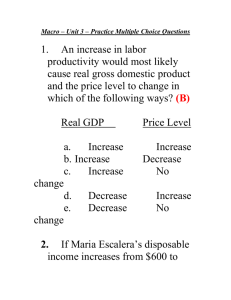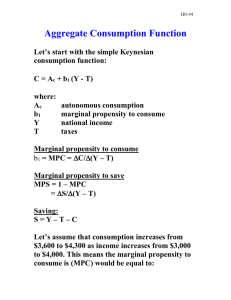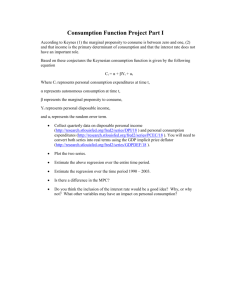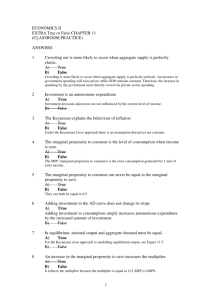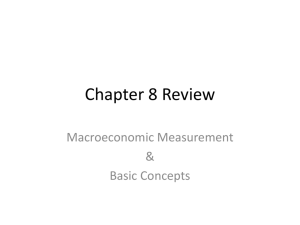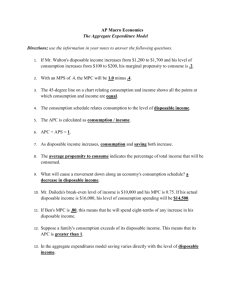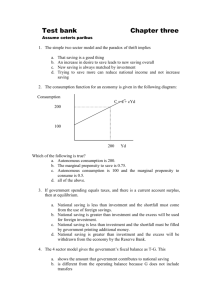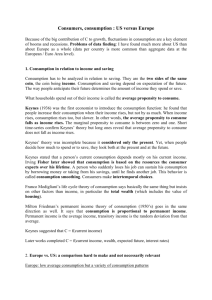(i) Average Propensity to Consume.
advertisement
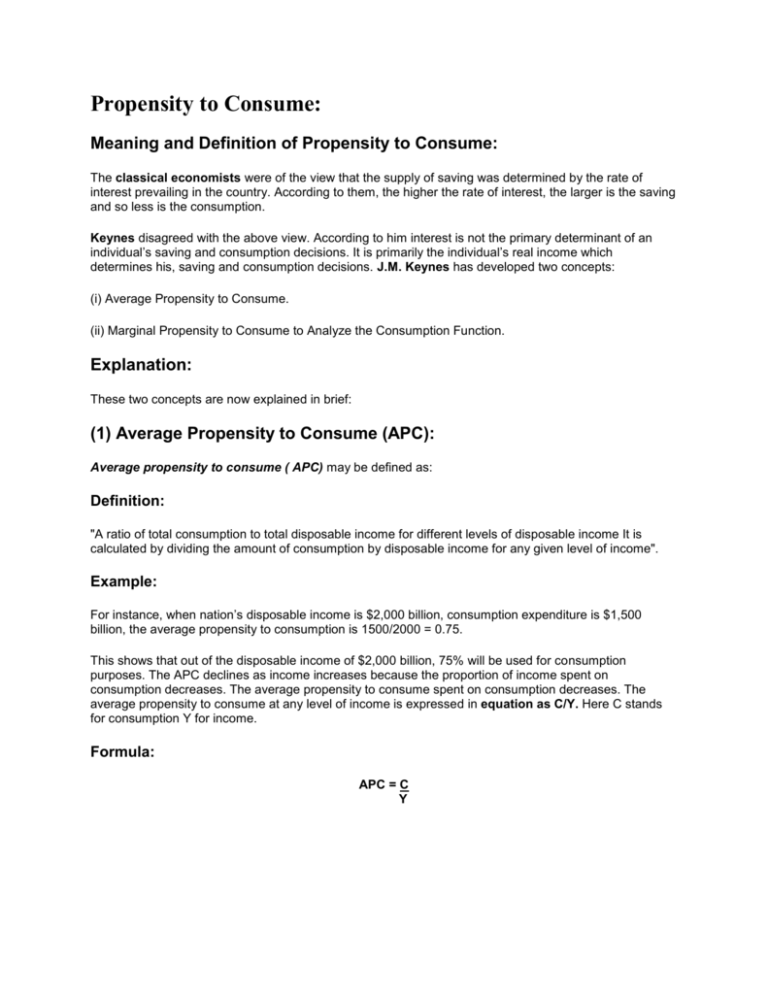
Propensity to Consume: Meaning and Definition of Propensity to Consume: The classical economists were of the view that the supply of saving was determined by the rate of interest prevailing in the country. According to them, the higher the rate of interest, the larger is the saving and so less is the consumption. Keynes disagreed with the above view. According to him interest is not the primary determinant of an individual’s saving and consumption decisions. It is primarily the individual’s real income which determines his, saving and consumption decisions. J.M. Keynes has developed two concepts: (i) Average Propensity to Consume. (ii) Marginal Propensity to Consume to Analyze the Consumption Function. Explanation: These two concepts are now explained in brief: (1) Average Propensity to Consume (APC): Average propensity to consume ( APC) may be defined as: Definition: "A ratio of total consumption to total disposable income for different levels of disposable income It is calculated by dividing the amount of consumption by disposable income for any given level of income". Example: For instance, when nation’s disposable income is $2,000 billion, consumption expenditure is $1,500 billion, the average propensity to consumption is 1500/2000 = 0.75. This shows that out of the disposable income of $2,000 billion, 75% will be used for consumption purposes. The APC declines as income increases because the proportion of income spent on consumption decreases. The average propensity to consume spent on consumption decreases. The average propensity to consume at any level of income is expressed in equation as C/Y. Here C stands for consumption Y for income. Formula: APC = C Y Diagram: In the Fig.(30.2) income is plotted on OX axis and consumption along OY. CC curve represents the propensity to consume schedule. At point K, the average propensity to consume is equal to 0.62. KL/OL = (C/Y) i.e., 2500/4000 or 25/40 = 0.62 APC implies a point on the curve C which indicates the ratio of income consumed. The C curve is made up of a series such points. (2) Marginal Propensity to Consume (MPC): Definition: The concept of marginal propensity to consume is very important is macro economics. J.M. Keynes has defined marginal propensity to consume (MPC): "As the relationship between a change in consumption (ΔC) that resulted from a change in disposable income (ΔY)". Formula: It is found out by dividing change in consumption to a given change in disposable Income. MPC = Change in Consumption = ΔC Change in Income ΔY Example: Thus we make this concept clear by taking an example, let us suppose the disposable income rises from $2000 billion to $3000 billion ( by $1000 billion) and the consumption expenditure increases from $1500 billion to $2000 billion (by $500 billion). The marginal propensity to consume is: ΔC/ΔY = 500/1000 = 1/2 = 0.5 All the concepts of consumption function are now explained whit help of schedule and a diagram. Schedule For Propensity to Consume: Disposal Income (Y) Consumption Expenditure (C) Average Propensity to Consume (APC = C/Y) ($ in billion) Marginal Propensity to Consume (MPC = ΔC/ΔY) A 1000 1100 1.1 800/1000 = 0.9 B 2000 2000 1.0 600/1000 = 0.6 C 3000 2600 0.86 500/1000 = 0.5 D 4000 3100 0.77 300/1000 = 0.3 E 5000 3400 0.68 200/1000 = 0.2 F 6000 3600 0.6 100/1000 = 0.1 G 7000 3700 0.53 The reader can easily understand from the above schedule that with the increase in the disposable income, the propensity to consume decreases and conversely with a fall in income, the propensity to consume and the marginal propensity to consume increases. The consumption schedule can also be explained with the help of a curve which is given below: Diagram For Propensity to Consume: In the figure (30.3), disposable income is measured along the horizontal axis OX and consumption along the vertical axis OY. Let us now draw 450 helping line from O to ON. If we take any point on the 450 helping line, income will be exactly equal to expenditure. The curve AG represents the income consumption schedule, indicating the propensity to consumer at various levels of income. Point A which is above 450 helping line, shows us that the expenditure is greater than its income. This deficit in income can be converted either by borrowing or from the sale of assets. At point B, consumption expenditures exactly equal to disposable income and there is neither saving nor dis-saving. This point is known is as break even point. From B onward up to G, the curve lies below the 450 helping line. This shows that the consumption expenditure is less than the disposable income. Net saving is measured by the distance from the propensity to consume curve up to 450 helping line. For example, when the income is $5,000 billion, the expenditure is $3400 billion and saving $1,600 billion. Marginal propensity to consume curve can also be illustrated from the very same figure. At point B, income is $2,000 billion and is equal to expenditure, i.e., $2,000. When income increases from $2,000 billion to $3,000 billion, consumption increases only by $600 billion. Now we move from point B towards right up by $1,000 billion. BM line shows as the increases in income. Then we go vertically until we reach point K. MK line indicates addition made to the total consumption. It is equal to $600 billion. So the marginal propensity to consume will be equal to $600/$1000 = $6. Classical Theory of Employment: Definition and Explanation: Classic economics covers a century and a half of economic teaching. Adam Smith wrote a classic book entitled, 'An Enquiry into the Nature and Causes of the Wealth of Nations' in 1776. Since the publication of that book, a body of classic economic theory was developed gradually. However, the classic theory owes its origin to the works of David Ricardo (1772 -1823), T. S. Mill, J. B. Say and finally ends with the works of A. C. Pigou (1877-1959). There is no one single theory which can be labeled as classical theory of employment. In fact the classical theory of employment is composed of different views of classical economists on the issue of income and employment in the economy. According to the classical economists, the economy normally operates at the level of full employment without inflation in the long period. They assumed that wages and prices of goods were flexible and the competitive market existed in the economy (laisse-fair economy). The classical model, however, did not rule out the existence of over production and hence temporary unemployment in the economy. According to classics, if market forces are allowed to operate in the economic system, they will eliminate over production and make the economy produce output at the level of full employment. The classical economists were of the view that when the economy was at full employment level, that did not mean non existence of unemployed workers. Even at full employment level, there would be workers who would be frictionally or voluntarily unemployed. In a normal situation, if prices and wages are assumed to adjust freely and quickly, then in the commodity and labor market, the economic system will operate at the level of full employment in the long run. Principles of Classical Theory of Employment: The classical theory of employment is based on the following principles: (1) Say's Law of Market. (2) Equilibrium in the Labor Market. (3) Classical Analysis of Price and Inflation. (1) Say's Law of Market: J. B. Say (1776 - 1832) was a French economist and an industrialist. He was influenced by the writings of Adam Smith and David Ricardo. According to J. B. Say: "When goods are produced by firms in the economy, they pay reward to the factors of production. The households after receiving rewards of the factors of production spend the amount on the purchase of goods and services. From this it follows that each product produced in the economy creates demand equal to its value in the market". This conclusion came to be known as Say's Law of Market. Statement and Explanation of Say's Law of Market: "Say's Law of market states that supply creates its own demand". The income a person receives from production is spent to purchase goods and services by others. For the economy as a whole, therefore, total production equals total income. From this it implies that when the production of goods generate income sufficient to purchase goods, then there will be no deficiency of demand for goods, there will be no over production of goods and so no lay off or genera! unemployment for the workers. The essence of Say's law is that whatever the economy generates is automatically spent on the purchase of goods and services The economy is, therefore, self correcting. Its market always clear. Because of this self-adjustment, the economy operates automatically to full employment level as if guided by Adam Smith's "Invisible hand". Diagram/Figure: Say's Law is explained with the help of simplified circular flow in figure 32.1. Says Law means that supply creates its own demand for goods and services. The income persons receive from output is spent to purchase goods and services produced by others. The very act of supplying certain level of goods and services necessarily equals the level of goods and services demanded. For the economy as a whole, total production therefore equals total income. Assumptions of the Say's Law of Market: The classical model is based mainly on the following four assumptions: (i) Pure competition exists. No single buyer or seller of commodity or an input can affect its price. (ii) Wages and prices are flexible. The wages and prices of goods are free to move to whatever level the supply and demand dictate. (iii) Self interest. People are motivated by self interest. The businessmen want to maximize their profits and the households want to maximize their economic well being. (iv) No government interference. There is no necessity on the part of the government to intervene in the business matters. It may here be noted that if a part of the economy's income is saved, the Say's Law of Market would still hold good, It is because of the reason that whatever amount is saved is invested by businessmen on capital goods. Saving is equal to investment. Aggregate spending thus will be equal to aggregate income and the economy operates at the level of a full employment. The classical economists, however, maintained that if at any time there is divergence between saving and investment, the equality between the two is maintained through the mechanism of rate of interest. For example, if at any time, the flow of savings is greater than the flow of investment, the rate of interest will fall. This will lead to an increase in investment and fall in saving till the two are equal at the full employment level. We find from Say's Law of Market, that saving is an increasing function of the interest rate and investment a decreasing function of the rate of interest. (2) Equilibrium in the Labor Market: Another feature of the classical theory of employment is in its belief that that if real wages of the workers are flexible in the labor market, then the economic system automatically adjusts itself at the level of full employment. According to A. C. Pigou: "The equilibrium level of employment is determined by the demand for and supply of labor in the labor market. So far the demand for labor is concerned, it is the decreasing function of higher wages. This means that at higher wages, the firms will employ less units of workers. As the real wage rates fall, then more units of workers are demanded by the firms". As regards the supply of labor, it is the increasing functions of real wages. This means that at higher wage rates, more workers will be willing to work. The equilibrium level of employment which is the full employment level is determined by the equation of demand for and supply of labor. The classical theory of employment is now explained with the help of diagram. Diagram/Figure: In the Fig. 32.2, the labor demand curve DD/ shows the total quantity of workers that firms plan to hire at each possible real wage rates. The labor supply curve SS/ shows the total quantity of workers that households plan to supply at each possible wage rate. The labor demand curve DD / and the labor supply curve SS/ interact to determine the level of employment. In this fig, it is shown that when the real wage rate is $12 per day, then 135 million workers employed represented full employment equilibrium. In case the real wage rate is $14 per day, the supply of workers is 145 million whereas the firms would want to hire only 125 million workers, there would be surplus labor or unemployment of 20 million workers. In the classical model, the unemployment of 20 million workers will be eliminated by real wage rate dropping to $12 per day. At wage rate below $12 per day, there is labor shortage. The situation of labor shortage does not last for a longer period. The real wage rate rises to $12 per day with full employment equilibrium of 135 million workers. (3) Classical Analysis of Prices and Inflation: The classical economists were of the view also that price level (P) in the economy is dependent upon the supply of money (M) in the country. The greater the quantity of money, the higher is the price level and vice versa. This analysis of price level was based on the Quantity Theory of Money, which in brief rates that price level (P) is directly related to the quantity of money in circulation in the economy (M). Keynes Criticism on Say's Law: The law of J.B. Say was finally falsified and laid to rest with the writings of Lord J.M. Keynes. He in his book, 'General Theory', has severally criticized the Say's Law on the following grounds: (i) Possibility of deficiency of effective demand. According to Keynes, the classical theory based on Say's Law is unreal. In a competitive market, he says, it is not necessary that all income earned is automatically spent on consumption and investment. A part of income may be saved and may go to increase individual holdings. There may, thus, appear a deficiency in aggregate demand causing overproduction and unemployment in the country. (ii) Pigou's view on wage cuts. Keynes criticizes Pigou's view that a general cut in real wages in times of depression is a cure for unemployment. Keynes is of the opinion that a general cut in real wages may reduce the aggregate demand for goods and deepen depression. (iii) Not a general theory. The Say's Law assumes that micro economic analysis can profitably by applied to the economy as a whole. Keynes rejects this view and says that for the explanation of the general theory of income and employment, the macro economic analysis is required. (iv) Saving investment equality. Keynes was never convinced of the classical version that interest elasticity can equate savings and investment. According to him, it is the income and not the rate of interest which is the equilibrium, force between saving and investment. (v) Monopoly element. Say's Law assumes perfect competition in the economy. Keynes says it is the imperfect competition which in practice prevails in the product and factor markets. The Say's Law is therefore, not operative. (vi) Role of trade unions. In the contemporary capitalist world, the trade unions bargain with the employers for the fixation of wages. The state also fixes minimum wages in certain industries. The classical theory did not attach much importance to these forces and relied more on the theoretical; aspect, J.M. Keynes emphasizes more on the practical side of the theory of employment. In the words of Dillard" the great fault of the classical theory is its irrelevance to conditions in the contemporary capitalist world. In capitalistic economy where widespread unemployment, business cycles, inflation, and other forms of instability constitute the chief problems of public policy, the basic need is for a theory that will diagnose these ills in a manner which wilt furnish a guide to action for their solution or alleviation. Such a new and more relevant theory has emerged in Keynes General Theory of Employment, Interest and Money. (vii) Short run economics. Keynes rejects Says Law that aggregate demand will always be sufficient to buy what is supplied in the long run. Keynes remarks that "In the long run we are all dead". The length of long run is not clear in Say's Law.
